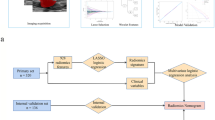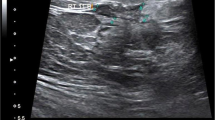Abstract
Objectives
To investigate the correlation of three-dimensional (3D) ultrasound features with prognostic factors in invasive ductal carcinoma.
Methods
Surgical resection specimens of 85 invasive ductal carcinomas of 85 women who had undergone 3D ultrasound were included. Morphology features and vascularization perfusion on 3D ultrasound were evaluated. Pathologic prognostic factors, including tumour size, histological grade, lymph node status, oestrogen and progesterone receptor status (ER, PR), c-erbB-2 and p53 expression, and microvessel density (MVD) were determined. Correlations of 3D ultrasound features and prognostic factors were analysed.
Results
The retraction pattern in the coronal plane had a significant value as an independent predictor of a small tumour size (P = 0.014), a lower histological grade (P = 0.009) and positive ER or PR expression status (P = 0.001, 0.044). The retraction pattern with a hyperechoic ring only existed in low-grade and ER-positive tumours. The presence of the hyperechoic ring strengthened the ability of the retraction pattern to predict a good prognosis of breast cancer. The increased intra-tumour vascularization index (VI, the mean tumour vascularity) reflected a higher histological grade (P = 0.025) and had a positive correlation with MVD (r = 0.530, P = 0.001).
Conclusions
The retraction pattern and histogram indices of VI provided by 3D ultrasound may be useful in predicting prognostic information about breast cancer.
Key Points
• Three-dimensional ultrasound can potentially provide prognostic evaluation of breast cancer.
• The retraction pattern and hyperechoic ring in the coronal plane suggest good prognosis.
• The increased intra-tumour vascularization index reflects a higher histological grade.
• The intra-tumour vascularization index is positively correlated with microvessel density.




Similar content being viewed by others
References
Goldhirsch A, Ingle JN, Gelber RD et al (2009) Thresholds for therapies: highlights of the St Gallen International Expert Consensus on the primary therapy of early breast cancer 2009. Ann Oncol 20:1319–1329
Elston CW, Ellis IO, Pinder SE (1999) Pathological prognostic factors in breast cancer. Crit Rev Oncol Hematol 31:209–223
Hussein MR, Abd-Elwahed SR, Abdulwahed AR (2008) Alterations of estrogen receptors, progesterone receptors and c-erbB2 oncogene protein expression in ductal carcinomas of the breast. Cell Biol Int 32:698–707
Weidner N (1995) Current pathologic methods for measuring intratumoral microvessel density within breast carcinoma and other solid tumors. Breast Cancer Res Treat 36:169–180
Candelaria RP, Hwang L, Bouchard RR, Whitman GJ (2013) Breast ultrasound: current concepts. Semin Ultrasound CT MR 34:213–225
Hashimoto BE (2011) New sonographic breast technologies. Semin Roentgenol 46:292–301
Chen DR, Lai HW (2011) Three-dimensional ultrasonography for breast malignancy detection. Expert Opin Med Diagn 5:253–261
Rotten D, Levaillant JM, Constancis E, Collet Billon A, Le Guerinel Y, Rua P (1991) Three-dimensional imaging of solid breast tumors with ultrasound: preliminary data and analysis of its possible contribution to the understanding of the standard two-dimensional sonographic images. Ultrasound Obstet Gynecol 1:384–390
Rotten D, Levaillant JM, Zerat L (1999) Analysis of normal breast tissue and of solid breast masses using three-dimensional ultrasound mammography. Ultrasound Obstet Gynecol 14:114–124
Chen ST, Kuo SJ, Wu HK, Chen LS, Chen DR (2013) Power Doppler breast ultrasound: association of vascularization and ER/c-erbB-2 co-expression in invasive breast carcinoma. Breast Cancer 20:152–158
Raine-Fenning NJ, Campbell BK, Clewes JS, Kendall NR, Johnson IR (2003) The reliability of virtual organ computer-aided analysis (VOCAL) for the semiquantification of ovarian, endometrial and subendometrial perfusion. Ultrasound Obstet Gynecol 22:633–639
Cho N, Moon WK, Cha JH et al (2006) Differentiating benign from malignant solid breast masses: comparison of two-dimensional and three-dimensional US. Radiology 240:26–32
Warm M, Duda V, Eichler C et al (2011) 3D breast ultrasound: a significant predictor in breast cancer reduction under pre-operative chemotherapy. Anticancer Res 31:4039–4042
Delle Chiaie L, Terinde R (2004) Three-dimensional ultrasound-validated large-core needle biopsy: is it a reliable method for the histological assessment of breast lesions? Ultrasound Obstet Gynecol 23:393–397
Kalmantis K, Dimitrakakis C, Koumpis C et al (2009) The contribution of three-dimensional power Doppler imaging in the preoperative assessment of breast tumors: a preliminary report. Obstet Gynecol Int 2009:530–579
Lin X, Wang J, Han F, Fu J, Li A (2012) Analysis of eighty-one cases with breast lesions using automated breast volume scanner and comparison with handheld ultrasound. Eur J Radiol 81:873–878
Huang SF, Chang RF, Chen DR, Moon WK (2004) Characterization of spiculation on ultrasound lesions. IEEE Trans Med Imaging 23:111–121
Franquet T, De Miguel C, Cozcolluela R, Donoso L (1993) Spiculated lesions of the breast: mammographic-pathologic correlation. Radiographics 13:841–852
Lamb PM, Perry NM, Vinnicombe SJ, Wells CA (2000) Correlation between ultrasound characteristics, mammographic findings and histological grade in patients with invasive ductal carcinoma of the breast. Clin Radiol 55:40–44
Evans AJ, Pinder SE, James JJ, Ellis IO, Cornford E (2006) Is mammographic spiculation an independent, good prognostic factor in screening-detected invasive breast cancer? AJR Am J Roentgenol 187:1377–1380
Tabar L, Tony Chen HH, Amy Yen MF et al (2004) Mammographic tumor features can predict long-term outcomes reliably in women with 1–14-mm invasive breast carcinoma. Cancer 101:1745–1759
Kojima Y, Tsunoda H (2011) Mammography and ultrasound features of triple-negative breast cancer. Breast Cancer 18:146–151
Luck AA, Evans AJ, James JJ et al (2008) Breast carcinoma with basal phenotype: mammographic findings. AJR Am J Roentgenol 191:346–351
Stavros AT, Thickman D, Rapp CL, Dennis MA, Parker SH, Sisney GA (1995) Solid breast nodules: use of sonography to distinguish between benign and malignant lesions. Radiology 196:123–134
Weidner N, Folkman J, Pozza F et al (1992) Tumor angiogenesis: a new significant and independent prognostic indicator in early-stage breast carcinoma. J Natl Cancer Inst 84:1875–1887
El-Gendi S, Abdel-Hadi M (2009) Lymphatic vessel density as prognostic factor in breast carcinoma: relation to clinicopathologic parameters. J Egypt Natl Canc Inst 21:139–149
Choi WW, Lewis MM, Lawson D et al (2005) Angiogenic and lymphangiogenic microvessel density in breast carcinoma: correlation with clinicopathologic parameters and VEGF-family gene expression. Mod Pathol 18:143–152
Koukourakis MI, Manolas C, Minopoulos G, Giatromanolaki A, Sivridis E (2003) Angiogenesis relates to estrogen receptor negativity, c-erbB-2 overexpression and early relapse in node-negative ductal carcinoma of the breast. Int J Surg Pathol 11:29–34
Chang YC, Huang YH, Huang CS, Chang RF (2012) Vascular morphology and tortuosity analysis of breast tumor inside and outside contour by 3-D power Doppler ultrasound. Ultrasound Med Biol 38:1859–1869
Abbattista T, Serri L, Busilacchi P (2007) Three-dimensional sonographic study of breast nodules. J Ultrasound 10:93–98
Yang WT, Tse GM, Lam PK, Metreweli C, Chang J (2002) Correlation between color power Doppler sonographic measurement of breast tumor vasculature and immunohistochemical analysis of microvessel density for the quantitation of angiogenesis. J Ultrasound Med 21:1227–1235
Sterns EE, SenGupta S, Saunders F, Zee B (1996) Vascularity demonstrated by Doppler ultrasound and immunohistochemistry in invasive ductal carcinoma of the breast. Breast Cancer Res Treat 40:197–203
Acknowledgments
The scientific guarantor of this publication is Ya-qing Chen. This study has received funding by the National Natural Science Foundation of China (81271595, 81301233), and the Shanghai Jiaotong University Foundation (11XJ21019, YG2011MS43). Xiao-jin Wang kindly provided statistical advice for this manuscript. Institutional review board approval was obtained. Written informed consent was obtained from all subjects (patients) in this study. Methodology: retrospective, diagnostic or prognostic study, performed at one institution.
Author information
Authors and Affiliations
Corresponding author
Rights and permissions
About this article
Cite this article
Jiang, J., Chen, Yq., Xu, Yz. et al. Correlation between three-dimensional ultrasound features and pathological prognostic factors in breast cancer. Eur Radiol 24, 1186–1196 (2014). https://doi.org/10.1007/s00330-014-3135-8
Received:
Revised:
Accepted:
Published:
Issue Date:
DOI: https://doi.org/10.1007/s00330-014-3135-8




